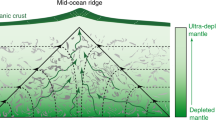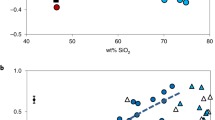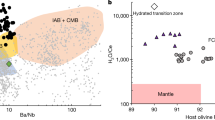Abstract
The extent to which water and halogens in Earth’s mantle have primordial origins, or are dominated by seawater-derived components introduced by subduction is debated. About 90% of non-radiogenic xenon in the Earth’s mantle has a subducted atmospheric origin, but the degree to which atmospheric gases and other seawater components are coupled during subduction is unclear. Here we present the concentrations of water and halogens in samples of magmatic glasses collected from mid-ocean ridges and ocean islands globally. We show that water and halogen enrichment is unexpectedly associated with trace element signatures characteristic of dehydrated oceanic crust, and that the most incompatible halogens have relatively uniform abundance ratios that are different from primitive mantle values. Taken together, these results imply that Earth’s mantle is highly processed and that most of its water and halogens were introduced by the subduction of serpentinized lithospheric mantle associated with dehydrated oceanic crust.
This is a preview of subscription content, access via your institution
Access options
Access Nature and 54 other Nature Portfolio journals
Get Nature+, our best-value online-access subscription
$29.99 / 30 days
cancel any time
Subscribe to this journal
Receive 12 print issues and online access
$259.00 per year
only $21.58 per issue
Buy this article
- Purchase on Springer Link
- Instant access to full article PDF
Prices may be subject to local taxes which are calculated during checkout




Similar content being viewed by others
References
Schilling, J. G., Unni, C. K. & Bender, M. L. Origin of chlorine and bromine in the oceans. Nature 273, 631–636 (1978).
Dixon, J. E., Leist, L., Langmuir, C. & Schilling, J.-G. Recycled dehydrated lithosphere observed in plume-influenced mid-ocean-ridge basalt. Nature 420, 385–389 (2002).
Parai, R. & Mukhopadhyay, S. How large is the subducted water flux? New constraints on mantle regassing rates. Earth Planet. Sci. Lett. 317, 396–406 (2012).
Stroncik, N. A. & Haase, K. M. Chlorine in oceanic intraplate basalts: constraints on mantle sources and recycling processes. Geology 32, 945–948 (2004).
Caracausi, A., Avice, G., Burnard, P. G., Füri, E. & Marty, B. Chondritic xenon in the Earth’s mantle. Nature 533, 82–85 (2016).
Holland, G. & Ballentine, C. J. Seawater subduction controls the heavy noble gas composition of the mantle. Nature 441, 186–191 (2006).
Holland, G., Cassidy, M. & Ballentine, C. J. Meteorite Kr in Earth’s mantle suggests a late accretionary source for the atmosphere. Science 326, 1522–1525 (2009).
Chauvel, C., Hofmann, A. W. & Vidal, P. HIMU EM—the French-Polynesian connection. Earth Planet. Sci. Lett. 110, 99–119 (1992).
Stracke, A. Earth’s heterogeneous mantle: a product of convection-driven interaction between crust and mantle. Chem. Geol. 330, 274–299 (2012).
White, W. M. & Hofmann, A. W. Mantle heterogeneity and isotopes in oceanic basalts. Nature 295, 363–364 (1982).
Kendrick, M. A., Jackson, M. G., Hauri, E. & Phillips, D. The halogen (F, Cl, Br, I) and H2O systematics of Samoan lavas: assimilated seawater, EM2 and high 3He/4He components. Earth Planet. Sci. Lett. 410, 197–209 (2015).
Kendrick, M. A. et al. Contrasting behaviours of CO2, S, H2O and halogens (F, Cl, Br, and I) in enriched-mantle melts from Pitcairn and Society seamounts. Chem. Geol. 370, 69–81 (2014).
Wallace, P. J. Volatiles in submarine basaltic glasses from the Northern Kerguelen Plateau (ODP Site 1140): implications for source region compositions, magmatic processes and plateau subsidence. J. Petrol. 43, 1311–1326 (2002).
Hanyu, T. et al. Isotope evolution in the HIMU reservoir beneath St. Helena: implications for the mantle recycling of U and Th. Geochim. Cosmochim. Acta 143, 232–252 (2014).
Maia, M., Hemond, C. & Gente, P. Contrasted interactions between plume, upper mantle, and lithosphere: foundation chain case. Geochem. Geophys. Geosyst. 2, GC000117 (2001).
Stroncik, N. A. & Devey, C. W. Recycled gabbro signature in hotspot magmas unveiled by plume–ridge interactions. Nat. Geosci. 4, 393–397 (2011).
Kendrick, M. A., Arculus, R. J., Burnard, P. & Honda, M. Quantifying brine assimilation by submarine magmas: examples from the Galápagos Spreading Centre and Lau Basin. Geochim. Cosmochim. Acta 123, 150–165 (2013).
Cabral, R. A. et al. Volatile cycling of H2O, CO2, F, and Cl in the HIMU mantle: a new window provided by melt inclusions from oceanic hot spot lavas at Mangaia, Cook Islands. Geochem. Geophys. Geosyst. 15, 4445–4467 (2014).
Jackson, M. G. et al. Deeply dredged submarine HIMU glasses from the Tuvalu Islands, Polynesia: implications for volatile budgets of recycled oceanic crust. Geochem. Geophys. Geosyst. 16, GC005966 (2015).
Le Voyer, M., Cottrell, E., Kelley, K. A., Brounce, M. & Hauri, E. H. The effect of primary versus secondary processes on the volatile content of MORB glasses: an example from the equatorial Mid-Atlantic Ridge (5 degrees N-3 degrees S). J. Geophys. Res. 120, 125–144 (2015).
Schilling, J. G., Hanan, B. B., McCully, B., Kingsley, R. H. & Fontignie, D. Influence of the Sierra Leone mantle plume on the equatorial Mid-Atlantic Ridge: a Nd-Sr-Pb isotopic study. J. Geophys. Res. 99, 12005–12028 (1994).
Michael, P. J. & Cornell, W. C. Influence of spreading rate and magma supply on crystallization and assimilation beneath mid-ocean ridges: evidence from chlorine and major element chemistry of mid-ocean ridge basalts. J. Geophys. Res. 103, 18325–18356 (1998).
le Roux, P. J., Shirey, S. B., Hauri, E. H., Perfit, M. R. & Bender, J. F. The effects of variable sources, processes and contaminants on the composition of northern EPR MORB (8-10 degrees N and 12–14 degrees N): evidence from volatiles (H2O, CO2, S) and halogens (F, Cl). Earth Planet. Sci. Lett. 251, 209–231 (2006).
Kendrick, M. A., Honda, M. & Vanko, D. A. Halogens and noble gases in Mathematician Ridge meta-gabbros, NE Pacific: implications for oceanic hydrothermal root zones and global volatile cycles. Contrib. Mineral. Petrol. 170, 1–20 (2015).
Jambon, A., Deruelle, B., Dreibus, G. & Pineau, F. Chlorine and bromine abundance in MORB: the contrasting behaviour of the Mid-Atlantic Ridge and East Pacific Rise and implications for chlorine geodynamic cycle. Chem. Geol. 126, 101–117 (1995).
Shimizu, K. et al. Two-component mantle melting-mixing model for the generation of mid-ocean ridge basalts: implications for the volatile content of the Pacific upper mantle. Geochim. Cosmochim. Acta 176, 44–80 (2016).
Danyushevsky, L. V., Eggins, S. M., Falloon, T. J. & Christie, D. M. H2O abundance in depleted to moderately enriched mid-ocean ridge magmas; Part I: incompatible behaviour, implications for mantle storage, and origin of regional variations. J. Petrol. 41, 1329–1364 (2000).
Michael, P. Regionally distinctive sources of depleted MORB—evidence from trace elements and H2O. Earth Planet. Sci. Lett. 131, 301–320 (1995).
Niu, Y. L. & Batiza, R. Trace element evidence from seamounts for recycled oceanic crust in the eastern Pacific mantle. Earth Planet. Sci. Lett. 148, 471–483 (1997).
Sobolev, A. V. et al. The amount of recycled crust in sources of mantle-derived melts. Science 316, 412–417 (2007).
Kodolányi, J., Pettke, T., Spandler, C., Kamber, B. S. & Gméling, K. Geochemistry of ocean floor and fore-arc serpentinites: constraints on the ultramafic input to subduction zones. J. Petrol. 53, 235–270 (2012).
Kendrick, M. A. et al. Subduction zone fluxes of halogens and noble gases in seafloor and forearc serpentinites. Earth Planet. Sci. Lett. 365, 86–96 (2013).
Schmidt, M. W. & Poli, S. Experimentally based water budgets for dehydrating slabs and consequences for arc magma generation. Earth Planet. Sci. Lett. 163, 361–379 (1998).
Pamato, M. G. et al. Lower-mantle water reservoir implied by the extreme stability of a hydrous aluminosilicate. Nat. Geosci. 8, 75–79 (2015).
Herzberg, C. et al. Phantom Archean crust in Mangaia hotspot lavas and the meaning of heterogeneous mantle. Earth Planet. Sci. Lett. 396, 97–106 (2014).
Weiss, Y., Class, C., Goldstein, S. L. & Hanyu, T. Key new pieces of the HIMU puzzle from olivines and diamond inclusions. Nature 537, 666–670 (2016).
Saal, A. E., Hauri, E. H., Langmuir, C. H. & Perfit, M. R. Vapour undersaturation in primitive mid-ocean-ridge basalt and the volatile content of Earth’s upper mantle. Nature 419, 451–455 (2002).
Lyubetskaya, T. & Korenaga, J. Chemical composition of Earth’s primitive mantle and its variance: 1. Method and results. J. Geophys. Res. 112, B03211 (2007).
Palme, H. & O’Neill, H. S. C. in Treatise on Geochemistry Vol. 2 (eds Holland, H. & Turekian, K. K.) 1–38 (Elsevier, 2003).
Graham, D. W. in Reviews in Mineralogy and Geochemistry Vol. 47 (eds Porcelli, D., Ballentine, C. J. & Wieler, R.) 245–317 (Geochemical Society/ Mineralogical Society of America, 2002).
Allegre, C. J., Hofmann, A. & O’Nions, K. The argon constraints on mantle structure. Geophys. Res. Lett. 23, 3555–3557 (1996).
Deruelle, B., Dreibus, G. & Jambon, A. Iodine abundances in oceanic basalts: implications for Earth dynamics. Earth Planet. Sci. Lett. 108, 217–227 (1992).
Sobolev, A. V. et al. Komatiites reveal a hydrous Archaean deep-mantle reservoir. Nature 531, 628–632 (2016).
Pearson, D. G. et al. Hydrous mantle transition zone indicated by ringwoodite included within diamond. Nature 507, 221–224 (2014).
Kendrick, M. A., Scambelluri, M., Honda, M. & Phillips, D. High abundances of noble gas and chlorine delivered to the mantle by serpentinite subduction. Nat. Geosci. 4, 807–812 (2011).
Barry, P. H. & Hilton, D. R. Release of subducted sedimentary nitrogen throughout Earth’s mantle. Geochem. Perspect. Lett. 2, 148–159 (2016).
Ito, E., Harris, D. M. & Anderson, A. T. Alteration of oceanic-crust and geologic cycling of chlorine and water. Geochim. Cosmochim. Acta 47, 1613–1624 (1983).
Sharp, Z. D. et al. Chlorine isotope homogeneity of the mantle, crust and carbonaceous chondrites. Nature 446, 1062–1065 (2007).
Ranero, C. R., Phipps Morgan, J., McIntosh, K. & Reichert, C. Bending-related faulting and mantle serpentinization at the Middle America trench. Nature 425, 367–373 (2003).
Scambelluri, M., Fiebig, J., Malaspina, N., Muntener, O. & Pettke, T. Serpentinite subduction: implications for fluid processes and trace-element recycling. Int. Geol. Rev. 46, 595–613 (2004).
Kendrick, M. A. High precision Cl, Br and I determination in mineral standards using the noble gas method. Chem. Geol. 292–293, 116–126 (2012).
Workman, R. K., Hauri, E., Hart, S. R., Wang, J. & Blusztajn, J. Volatile and trace elements in basaltic glasses from Samoa: implications for water distribution in the mantle. Earth Planet. Sci. Lett. 241, 932–951 (2006).
Danyushevsky, L. V. et al. The H2O content of basalt glasses from Southwest Pacific back-arc basins. Earth Planet. Sci. Lett. 117, 347–362 (1993).
Manhes, G., Allegre, C. J. & Povost, A. U-Th-Pb systematics of the eucrite ‘Juvinas’: precise age determination and evidence for exotic lead. Geochem. Cosmochim. Acta 48, 2247–2264 (1984).
White, W. M. & Patchett, J. Hf-Nd-Sr isotopes and incompatible element abundances in Island Arcs—implications for magma origins and crust-mantle evolution. Earth Planet. Sci. Lett. 67, 167–185 (1984).
Richard, P., Shimizu, N. & Allegre, C. J. 143Nd–146Nd A natural tracer—application to oceanic basalts. Earth Planet. Sci. Lett. 31, 269–278 (1976).
Birck, J. L. Precision K-Rb isotopic analysis—application to Rb-Sr chronology. Chem. Geol. 56, 73–83 (1986).
Nier, A. O. The isotopic constitution of strontium, barium, bismuth, thallium and mercury. Phys. Rev. 54, 275–278 (1938).
Acknowledgements
M.A.K. is supported by an Australian Research Council Future Fellowship (project number FT13 0100141). This work was made possible by several national funding agencies that have facilitated scientific cruises and sample recovery from the seafloor over many years. Grants to M.R.P. from the National Science Foundation funded field programmes where samples were collected from the East Pacific Rise, Juan de Fuca Ridge and Galapagos Spreading Centre. We gratefully acknowledge technical staff that made the reported measurements possible including X. Zhang, P. Holden and P. Tollan at the ANU.
Author information
Authors and Affiliations
Contributions
M.A.K. conceived the project and undertook the majority of analyses. C.H. measured radiogenic isotopes in Foundation and St Helena samples at PSO-Brest and T.R. measured water by FT-IR at UTAS. C.H., V.S.K., C.W.D., L.D., M.G.J. and M.R.P. provided sample material and L.D. and V.S.K. provided major and/or trace element data associated with their samples. M.A.K. wrote the initial manuscript and incorporated comments from V.S.K., M.G.J., C.W.D., L.D., M.R.P. and C.H. into the final version.
Corresponding author
Ethics declarations
Competing interests
The authors declare no competing financial interests.
Supplementary information
Supplementary Information
Supplementary Information (PDF 2741 kb)
Supplementary Information
Supplementary Information (XLSX 384 kb)
Rights and permissions
About this article
Cite this article
Kendrick, M., Hémond, C., Kamenetsky, V. et al. Seawater cycled throughout Earth’s mantle in partially serpentinized lithosphere. Nature Geosci 10, 222–228 (2017). https://doi.org/10.1038/ngeo2902
Received:
Accepted:
Published:
Issue Date:
DOI: https://doi.org/10.1038/ngeo2902
This article is cited by
-
The stability of antigorite in subduction zones revisited: the effect of F on antigorite stability and its breakdown reactions at high pressures and high temperatures, with implications for the geochemical cycles of halogens
Contributions to Mineralogy and Petrology (2022)
-
Halogens in serpentinised-troctolites from the Atlantis Massif: implications for alteration and global volatile cycling
Contributions to Mineralogy and Petrology (2022)
-
In situ observation of chrysotile decomposition in the presence of NaCl-bearing aqueous fluid up to 5 GPa and 400 °C
Mineralogy and Petrology (2021)
-
Origin of arc magmatic signature: A temperature-dependent process for trace element (re)-mobilization in subduction zones
Scientific Reports (2019)
-
Deep hydrous mantle reservoir provides evidence for crustal recycling before 3.3 billion years ago
Nature (2019)



